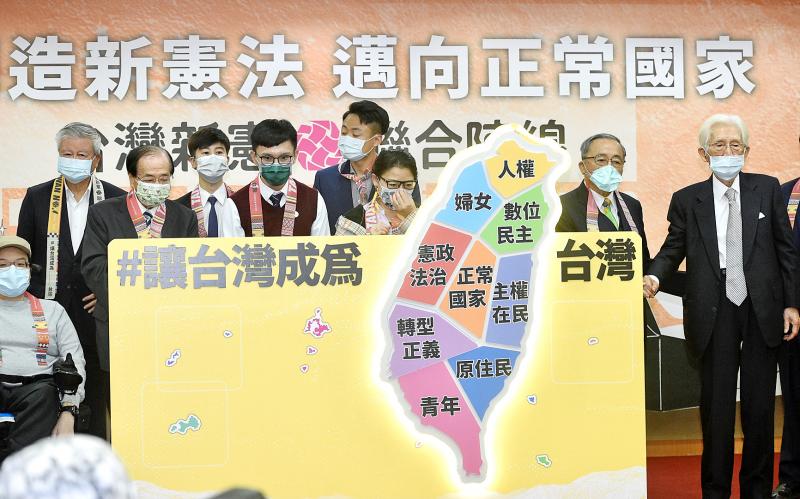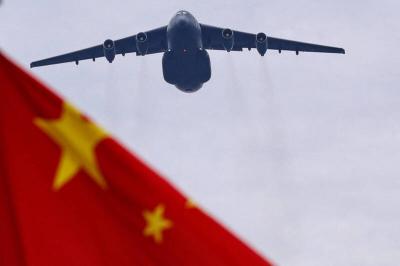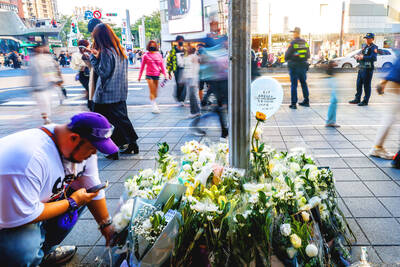Independence advocates yesterday launched the Taiwan New Constitution Alliance to promote drafting a new, localized constitution.
“This is a historic moment for Taiwan. Drafting a new constitution is the most important task Taiwanese face,” veteran independence advocate Koo Kwang-ming (辜寬敏) said at the inaugural event in Taipei.
“Although the Democratic Progressive Party is in power, its authority is based on the Republic of China [ROC] Constitution, which has no connection to Taiwan,” said the 95-year-old Koo, a former presidential adviser.

Photo: George Tsorng, Taipei Times
“The historic task of drafting a new constitution depends on efforts by all Taiwanese,” Koo said. “A constitution for a sovereign, independent Taiwan is not just for the benefit of those of us alive today, but also for that of our children and grandchildren.”
“The ROC Constitution was drafted in and for China, by representatives of the Chinese Nationalist Party [KMT],” said Lee Hung-hsi (李鴻禧), constitutional expert and law professor at National Taiwan University, adding that a new constitution for Taiwan should have been drafted much earlier.
Representatives of the Taiwan New Constitution Foundation, which is chaired by Koo, read out a proclamation on the need for a new constitution, saying: “When provisions in the ROC Constitution are in conflict with the wishes of Taiwanese and their pursuit of happiness, people have the right to a new constitution.”
The ROC Constitution was ratified during a National Constituent Assembly meeting in Nanjing, China, in 1946, they said.
“Taiwanese were not involved in the process of drafting or ratifying it, and were never asked for consent,” they said. “It was imposed on Taiwan, but later was suspended as the KMT placed the nation under martial law.”
“In the decades before Taiwan’s democratization started in the 1990s, Taiwanese were not granted the rights stipulated in the Constitution, such as the freedoms of expression, assembly and the press,” they said.
“Taiwanese only had a minimal say at the local level, while Mainlanders held all relevant positions in the central government, including as lawmakers who were not elected by the public,” they added.
“The ROC Constitution is dead and exists in name only. As the constitution of China, it has been superseded by the People’s Republic of China constitution,” they said.
A new constitution would omit the obsolete provisions in place and better represent the reality of two separate entities on both sides of the Taiwan Strait, they said.
“A new constitution would do away with the myth of a unification with China,” they said. “It would be an expression of the Taiwanese public’s will for self-determination and safeguard their dignity.”

Beijing could eventually see a full amphibious invasion of Taiwan as the only "prudent" way to bring about unification, the US Department of Defense said in a newly released annual report to Congress. The Pentagon's "Annual Report to Congress: Military and Security Developments Involving the People's Republic of China 2025," was in many ways similar to last year’s report but reorganized the analysis of the options China has to take over Taiwan. Generally, according to the report, Chinese leaders view the People's Liberation Army's (PLA) capabilities for a Taiwan campaign as improving, but they remain uncertain about its readiness to successfully seize

Taiwan is getting a day off on Christmas for the first time in 25 years. The change comes after opposition parties passed a law earlier this year to add or restore five public holidays, including Constitution Day, which falls on today, Dec. 25. The day marks the 1947 adoption of the constitution of the Republic of China, as the government in Taipei is formally known. Back then the Chinese Nationalist Party (KMT) governed China from Nanjing. When the KMT, now an opposition party in Taiwan, passed the legislation on holidays, it said that they would help “commemorate the history of national development.” That

Taiwan has overtaken South Korea this year in per capita income for the first time in 23 years, IMF data showed. Per capita income is a nation’s GDP divided by the total population, used to compare average wealth levels across countries. Taiwan also beat Japan this year on per capita income, after surpassing it for the first time last year, US magazine Newsweek reported yesterday. Across Asia, Taiwan ranked fourth for per capita income at US$37,827 this year due to sustained economic growth, the report said. In the top three spots were Singapore, Macau and Hong Kong, it said. South

HORROR STORIES: One victim recounted not realizing they had been stabbed and seeing people bleeding, while another recalled breaking down in tears after fleeing A man on Friday died after he tried to fight the knife-wielding suspect who went on a stabbing spree near two of Taipei’s busiest metro stations, Taipei Mayor Chiang Wan-an (蔣萬安) said. The 57-year-old man, identified by his family name, Yu (余), encountered the suspect at Exit M7 of Taipei Main Station and immediately tried to stop him, but was fatally wounded and later died, Chiang said, calling the incident “heartbreaking.” Yu’s family would receive at least NT$5 million (US$158,584) in compensation through the Taipei Rapid Transit Corp’s (TRTC) insurance coverage, he said after convening an emergency security response meeting yesterday morning. National